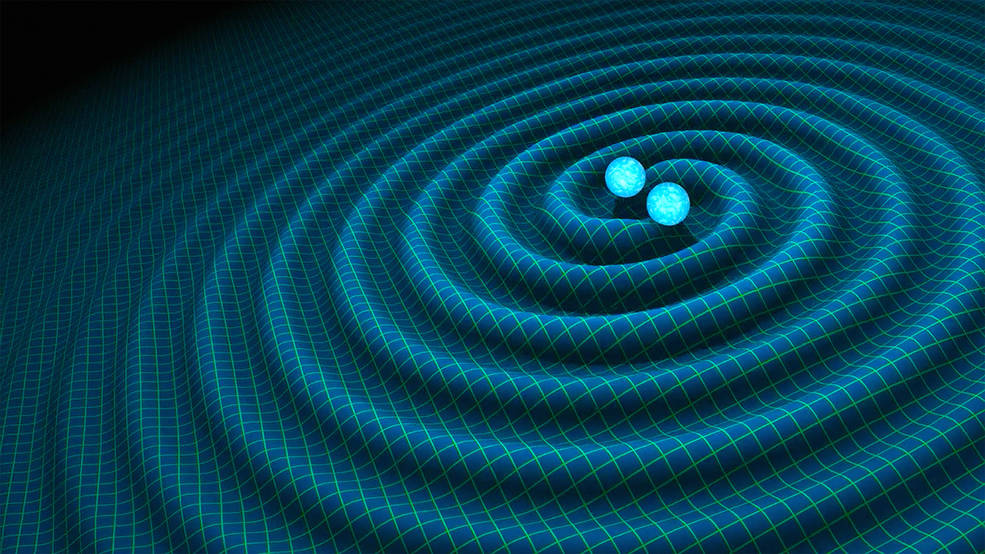Credits: R. Hurt/Caltech-JPL
In October 2017, following the observation of gamma-ray bursts, visible light, and gravitational waves, all from the same event (a ‘kilonova’, the merging of two incredibly dense neutron stars), several papers were published in the journal Nature and elsewhere outlining the importance of the discovery.
Elena Pian, astronomer with the Italian National Institute for Astrophysics (INAF), and lead author of one of these papers even went so far as to say that “There are rare occasions when a scientist has the chance to witness a new era at its beginning,”. So why, one might ask, is this the beginning of a new era?
To understand the beauty and utility of this observation, which astronomers are now calling multi-messenger astronomy, let’s follow the timeline of events surrounding the discovery – and look at what this one case of multi-messenger observation has taught us.
On 17 August 2017 the Laser Interferometer Gravitational-Wave Observatory (LIGO) and Virgo Interferometer simultaneously detected gravitational waves (ripples in the curvature of spacetime, first predicted by Einstein in 1916, and first observed in September 2015) passing Earth. The event was creatively named GW170817.
Two seconds later, two space observatories, NASA’s Fermi Gamma-ray Space Telescope and the European Space Agency’s (ESA) INTErnational Gamma Ray Astrophysics Laboratory (INTEGRAL), detected a short gamma-ray burst from the same area of the sky.
The Swope 1-metre telescope, operated by the Carnegie Institution, was the first ground-based telescope to announce a new point of light in the same patch of sky, appearing close to NGC 4943, a galaxy located in the constellation of Hydra.
After this first discovery, the light was picked up by a series of other telescopes located in Chile and the Hawaiian isles, and the European Southern Observatory (ESO) launched one of the biggest ever “target of opportunity” observing campaigns. These are observing campaign that begin as soon as the event is discovered, without requiring advanced notice – often due to the time sensitive nature of the observations. Many ESO and ESO-partnered telescopes observed the object over the weeks following the detection.
In total, about 70 observatories all over the world observed the event, across much of the electromagnetic spectrum (that is, from infrared light through to the visible and ultraviolet).
The event marked the first ever confirmed observation of a kilonova, which were first suggested more than 30 years ago. In addition, data obtained from the event indicates that Caesium and Tellurium were ejected from the merging neutron stars.
These and other heavy elements would have been created in the neutron merging event, and blown into space by the subsequent kilonova. Prior to this, the formation of elements heavier than iron through nuclear reactions within high-density stellar objects, known as r-process nucleosynthesis, had only ever been theorised.
Dr Morgan Fraser, a Royal Society-Science Foundation Ireland University Research Fellow at UCD School of Physics, was one of the astronomers involved in confirming that the recent gravitational waves source was a kilonova. This was done by showing that the observed light’s behaviour matched with theoretical models.
We questioned Dr Fraser about what gravitational waves have to offer that electromagnetic waves do not, in illustrating the value of multi-messenger astronomy.
“Electromagnetic waves can only reach us from whatever part of a source is transparent to photons. So, in the case of a core-collapse supernova (for example), we see photons from the outer layers of an exploding star.
It typically takes months before the ejecta from the supernova explosion has expanded and cooled to the point where we can see photons from what would have been the center of the star that exploded.”
Note that electromagnetic waves travel via photons, which can be ‘blocked’ by matter, but gravitational waves do not travel via photons and are instead ripples in the fabric of spacetime itself. Thus something which is opaque to photons will happily allow gravitational waves to pass through.
“In contrast, gravitational waves reach us unimpeded from the core of the star at the instant it explodes. They can hence give us unique insight into the physics powering a supernova explosion – how the core-collapses during the initial milliseconds of a supernova.”
In short, rather than waiting until the obscuring matter surrounding the center of the exploded star dissipates – as we would need to do with electromagnetic waves – gravitational waves allow an immediate look into the center of a supernova.
In addition, some events may not be observable by electromagnetic waves at all, such as merging black holes, but can be studied in detail by gravitational waves.
We concluded by asking Dr Fraser what he thought the future holds for the study of gravitational waves, and we were happy to find that the hunt isn’t over yet.
“The next goal will be to find more neutron star mergers (kilonovae). We know now that we can find them, and we have a single example. But what we want next is a sample of 10, or 50, or 100 kilonovae. How diverse are they?
Do they all eject the same amount of matter, and produce similar quantities of heavy elements? Do they look different from different orientations? How does the diversity of short gamma-ray bursts correspond to the diversity in kilonovae? What can we say about the relativistic jet launched by short gamma-ray bursts? Lots of these question (and more) should be answered over the coming years.”
Let’s hope the future is bright and full of kilonovae.







